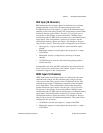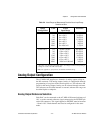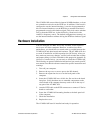
Chapter 2 Configuration and Installation
©
National Instruments Corporation 2-9 AT-MIO-16X User Manual
RSE Input (16 Channels)
RSE input means that all input signals are referenced to a common
ground point that is also tied to the analog input ground of the
AT-MIO-16X board. The negative (–) input of the differential input
amplifier is tied to the analog ground. This configuration is useful when
measuring floating signal sources. See the Types of Signal Sources
section later in this chapter for more information. With this input
configuration, the AT-MIO-16X can monitor up to 16 different analog
input signals. This configuration is selected via software. See the
configuration memory register and Table 4-9 in Chapter 4, Register
Map and Descriptions. The results of this configuration are as follows:
• The negative (–) input of the PGIA is tied to the PGIA signal
ground.
• Multiplexer outputs are tied together into the positive (+) input
of the PGIA.
• Multiplexer control is configured to control up to 16 input
channels.
• AI SENSE may be driven by the board analog input ground or
left unconnected.
Considerations for using the RSE configuration are discussed in the
Signal Connections section later in this chapter. Figure 2-18 shows
a schematic diagram of this configuration.
NRSE Input (16 Channels)
NRSE input means that all input signals are referenced to the same
common-mode voltage, but this common-mode voltage can float
with respect to the analog ground of the AT-MIO-16X board. This
common-mode voltage is subsequently subtracted from the signals
by the input PGIA. This configuration is useful when measuring
ground-referenced signal sources. See the Types of Signal Sources
section later in this chapter for more information. With this input
configuration, the AT-MIO-16X can measure up to 16 different analog
input signals. This configuration is selected via software. See the
configuration memory register and Table 4-9 in Chapter 4, Register
Map and Descriptions, for additional information. The results of this
configuration are as follows:
• AI SENSE is tied into the negative (–) input of the PGIA.
• Multiplexer outputs are tied together into the positive (+) input
of the PGIA.


















